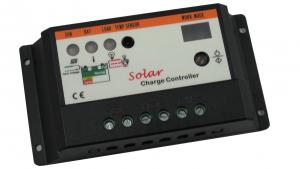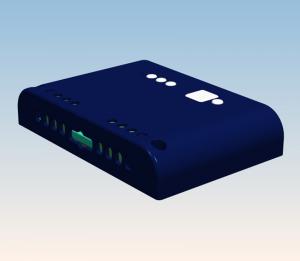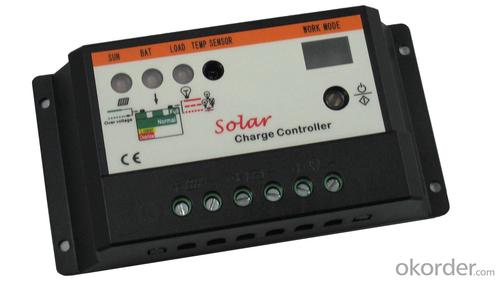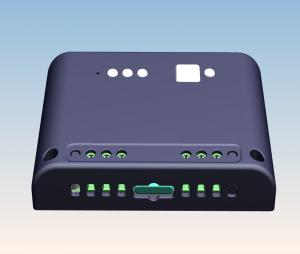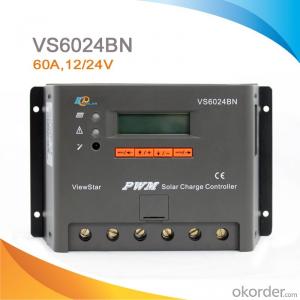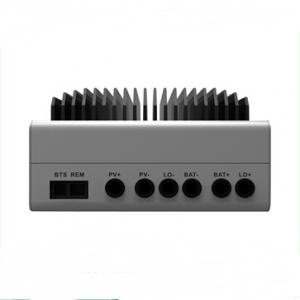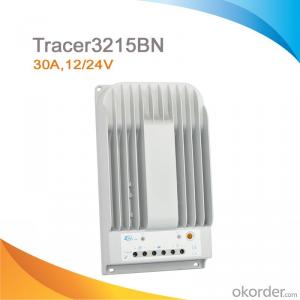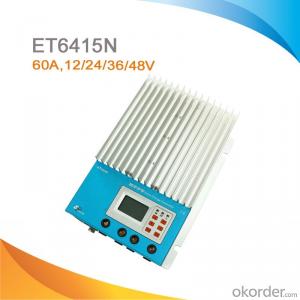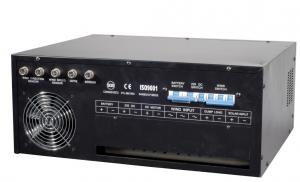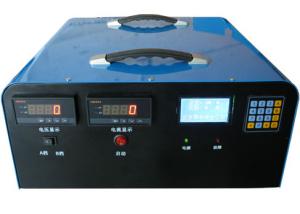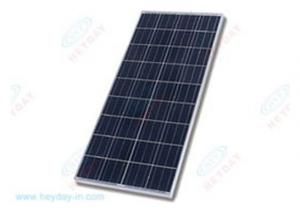P-Series PV Controller for Solar Electric Fence Controllers
- Loading Port:
- Nanjing
- Payment Terms:
- TT/LC
- Min Order Qty:
- 50sets set
- Supply Capability:
- 1-2000sets/month set/month
OKorder Service Pledge
OKorder Financial Service
You Might Also Like
Main features of P-Series PV controller:
Total positive control, multi-channel input matrix control of solar cells (for communication field)
Professional DSP control, charge and discharge point of each parameter can be set to meet the needs of different occasions
Brightest charge voltage detection with "bad back" control to prevent switching into oscillation state
Control circuit and main circuit completely isolated, with a high anti-interference ability
Protection function, operation status, fault LED indicate
LCD display screen, Chinese and English menu display
Clock display function
Variety of passive fault alarm output contact function
Historical records, password protection function
AH cumulative function of power (PV power generation, load power consumption ,battery power and other cumulative functions)
Low-power display state, further reducing its loss
Enables parallel operation of multiple machines
Against reverse battery
Remote monitoring (optional)
Optional Configuration of P- Series PV controller:
RS485/RS232 Remote monitoring;
Increase output control;
Technical Data of P-Series PV controller:
Voltage | 48V | 96V | 110V | 220V | 440V |
Rated current range | 100A~400A | 100A~500A | 100A~800A | ||
Battery input | |||||
Rated input -voltage (VDC) | 48 | 96 | 110 | 220 | 440 |
Under-voltage protection (VDC) | ≤43.2 | ≤86.4 | ≤99.0 | ≤198.0 | ≤388.0 |
Recovery voltage (VDC) | ≥49.2 | ≥98.4 | ≥115.0 | ≥230.0 | ≥460.0 |
Overvoltage protection (VDC) | ≥66.0 | ≥132.0 | ≥150.0 | ≥290.0 | ≥594.0 |
Overvoltage recovery (VDC) | ≤62.0 | ≤124.0 | ≤142.0 | ≤275.0 | ≤560.0 |
Solar input | |||||
Max. open circuit voltage(VDC) | 100.0 | 230.0 | 230.0 | 450.0 | 900.0 |
Max. charge current (A) | 400 | 400 | 500 | 500 | 800 |
Allow PV array points (N) | 10 | 12 | 20 | ||
Float voltage (VDC) | 54.8 | 109.6 | 125.0 | 251.0 | 493.2 |
Overcharge protection voltage (VDC) | ≥57.6 | ≥115.2 | ≥132.0 | ≥264.0 | ≥518.4 |
Charge recovery voltage (VDC) | ≤52.8 | ≤105.6 | ≤121.0 | ≤242.0 | ≤558.0 |
DC output | |||||
Max. output current (A) | 400 | 500 | 800 | ||
Overload capacity | 120% overload 60 seconds off the output / 150% overload for 10 seconds to close the output | ||||
Protection function | Battery over charge, over discharge the battery, the battery reversed,solar cells reversed , counter-attack by night charge , overheating, output overload, output short circuit | ||||
Serial communication | RS485(A、B) | ||||
Mechanical dimensions, work environment | |||||
Size (D x W x H) | 650 x 800 x 2260 | ||||
Reference weight (Kg) | 50 | ||||
Protection level | IP41 | ||||
Max. working altitude (m) | ≤3000 | ||||
Temperature range (℃) | -20 ~ +65 | ||||
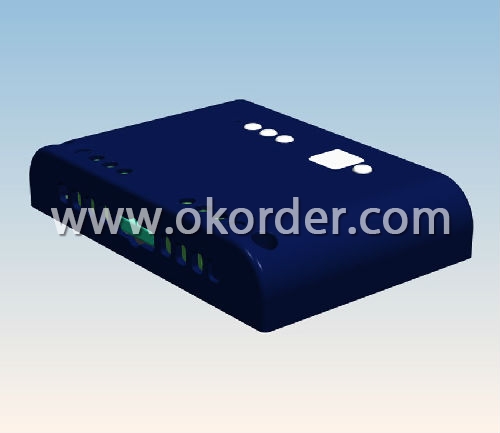
P-Series PV controller
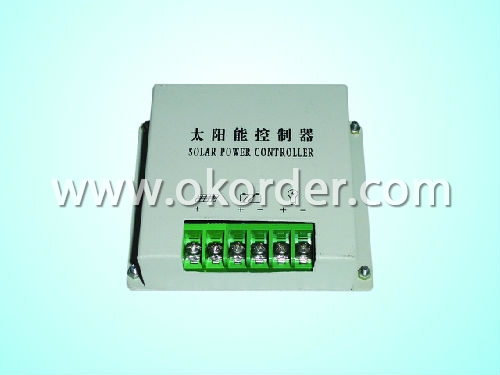
P-Series PV controller
Packaging & Delivery of P-Series PV controller
Packaging : Wooden box or Customized
Delivery: Depends on the quantity or Customized
- Q: How does a solar controller prevent damage to the solar panels from overvoltage conditions?
- The flow of electricity from the solar panels to the battery or grid is regulated by a solar controller to prevent damage to the panels caused by overvoltage conditions. Acting as a bridge between the panels and the battery or grid, it guarantees that the voltage output from the panels remains within safe limits. When generating electricity, the solar panels produce a voltage that varies depending on the intensity of sunlight. However, this voltage can fluctuate due to factors like weather conditions and panel temperature. Exceeding the safe operating range can result in panel damage. Constantly monitoring the voltage output from the panels, the solar controller activates a mechanism to prevent excess voltage from reaching the panels if it detects that the voltage is too high. Depending on the type of solar controller, this mechanism can involve techniques such as pulse width modulation (PWM) or maximum power point tracking (MPPT). PWM controllers regulate the voltage by rapidly switching the connection between the panels and the battery on and off. This effectively reduces the average voltage reaching the panels, preventing overvoltage conditions. On the other hand, MPPT controllers optimize energy conversion by adjusting the electrical load to extract maximum power from the panels without exceeding the safe voltage threshold. In both cases, the solar controller ensures that the voltage output from the panels remains within the specified range, safeguarding them from potential damage. Advanced solar controllers may also incorporate features such as temperature compensation to account for temperature variations, further enhancing the protection of the panels. In conclusion, a solar controller safeguards the solar panels from damage caused by overvoltage conditions by regulating and controlling the voltage output from the panels. Techniques like PWM or MPPT are employed to keep the voltage within safe limits. This protection mechanism prolongs the lifespan and enhances the efficiency of the panels, maximizing their performance and return on investment.
- Q: Can a solar controller be used with a solar-powered remote sensing system?
- Yes, a solar controller can be used with a solar-powered remote sensing system. A solar controller is responsible for regulating the power output from solar panels and managing the battery charging process. In a solar-powered remote sensing system, the solar controller will ensure that the solar panels efficiently charge the batteries that power the remote sensing equipment. This helps maintain a reliable and continuous power supply for the remote sensing system, making it an essential component for its operation.
- Q: Can a solar controller be used with a solar-powered off-grid community?
- Yes, a solar controller can be used with a solar-powered off-grid community. A solar controller is essential in regulating and optimizing the energy flow from the solar panels to the batteries, ensuring efficient charging and preventing overcharging or damage to the batteries. In an off-grid community relying on solar power, a solar controller is crucial for managing the solar energy system and maintaining a reliable power supply.
- Q: Can a solar controller be used with a solar-powered charging station for electric bikes?
- Yes, a solar controller can be used with a solar-powered charging station for electric bikes. A solar controller regulates and optimizes the flow of electricity from the solar panels to the charging station, ensuring efficient and safe charging of electric bikes.
- Q: Can a solar controller be used with different types of batteries (e.g., lead-acid, lithium-ion)?
- Yes, a solar controller can be used with different types of batteries, including lead-acid and lithium-ion. Solar controllers are designed to regulate and control the charging process of batteries, ensuring they are charged at the appropriate voltage and preventing overcharging or undercharging. They can be programmed or adjusted to accommodate the specific charging requirements of different battery types. This flexibility allows users to connect and charge various types of batteries with a single solar controller, making it a versatile and convenient solution for solar power systems.
- Q: Can a solar controller be used with a solar-powered EV charging station?
- Yes, a solar controller can be used with a solar-powered EV charging station. A solar controller helps regulate the flow of electricity from the solar panels to the charging station, ensuring optimal charging performance and protecting the batteries. It also helps manage excess energy and prevents overcharging.
- Q: What is the role of a solar controller in maintaining battery health and longevity?
- Maintaining battery health and longevity is of utmost importance, with the solar controller playing a crucial role in this regard. Commonly referred to as a charge controller, the solar controller regulates the flow of charge into the battery from the solar panels. One of the primary responsibilities of the solar controller is to prevent the battery from being overcharged. Overcharging can result in the release of gases and electrolyte loss, significantly shortening the battery's lifespan. To avoid this, the solar controller diligently monitors the battery's charge level and adjusts the charging current accordingly, ensuring that overcharging does not occur. Moreover, the solar controller also safeguards the battery against deep discharging. Deep discharges can inflict permanent damage on the battery, reducing its capacity and overall life expectancy. By constantly monitoring the battery's voltage, the controller disconnects the load when the voltage drops to a predetermined level, preventing further discharge. In addition to preventing overcharging and deep discharging, the solar controller provides protection against various potential issues that can harm the battery. It regulates the charging current to prevent excessive heat accumulation, which can be detrimental to the battery. Furthermore, it offers protection against reverse current flow during periods of low solar panel power generation or during nighttime. By efficiently managing the charging process, the solar controller maximizes the battery's lifespan and overall health. It ensures that the battery is charged optimally and shielded from detrimental conditions that can cause premature aging or failure. Hence, investing in a top-quality solar controller is imperative for maintaining the health and longevity of batteries in solar-powered systems.
- Q: Can a solar controller handle different load types (e.g., resistive, inductive)?
- No, a solar controller is not designed to handle different load types. It is primarily responsible for regulating the charging and discharging of batteries in a solar power system. The load types, such as resistive or inductive, should be handled by appropriate devices like inverters or converters that are specifically designed for those load types.
- Q: Can a solar controller handle power fluctuations from the grid?
- No, a solar controller cannot handle power fluctuations from the grid. A solar controller is designed to regulate and control the charging process of solar panels and batteries, and it does not have the capability to stabilize or handle power fluctuations from the grid.
- Q: Can a solar controller be used with solar panels of different colors?
- Yes, a solar controller can be used with solar panels of different colors. The color of the solar panels does not affect the functionality of the solar controller. The main purpose of a solar controller is to regulate the charging process of the batteries connected to the solar panels. It monitors the voltage and current from the solar panels and ensures that the batteries are charged in the most efficient and safe manner. The color of the solar panels simply refers to the aesthetics and does not impact the performance or compatibility with the solar controller.
Send your message to us
P-Series PV Controller for Solar Electric Fence Controllers
- Loading Port:
- Nanjing
- Payment Terms:
- TT/LC
- Min Order Qty:
- 50sets set
- Supply Capability:
- 1-2000sets/month set/month
OKorder Service Pledge
OKorder Financial Service
Similar products
Hot products
Hot Searches
Related keywords
